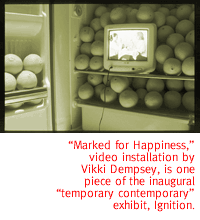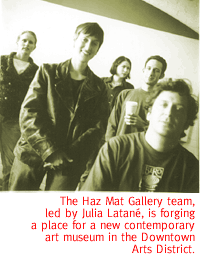

|

Contemporary Art Survives A Leaky Roof In A New Gallery.
By Margaret Regan
IT WAS A good thing, very good, that rain fell hard the
weekend after Thanksgiving. At least for the Museum of Contemporary
Art.
The roof leaks in the Toole Avenue warehouse where the museum
has temporarily alighted.
 "There are some pretty bad spots," says Julia Latané,
a museum founder.
"There are some pretty bad spots," says Julia Latané,
a museum founder.
The good part is that the rains came before Latané hung
the art for the museum's inaugural show, and the pools of water
on the wood floor helped her determine the no-art wet zones in
the sweeping space. The museum, brainchild of sculptor Latané,
her husband-photographer James Graham, and David Wright, a former
gallery owner, has existed only on paper for about two years.
Last Friday night, with the opening of its first show, Ignition,
a wide-ranging exhibition of the work of nine artists, the museum
manifested itself in brick and mortar as well. And art.
"We wanted a mix of knowns and unknowns (for the show),
things from every corner of contemporary art," Latané
said last week, in between hanging photos by New York artist Alix
Lambert. "Nothing connects the artists except for the high
quality of their craftsmanship and the fact that they're working
today."
For its first exhibition, the museum has rented digs in a decrepit
warehouse owned by the Arizona Department of Transportation along
the tracks at the north end of downtown. Once a storage space
for a typewriter company, Latané said, the building in
recent years served as studio to neon artist Philip Hazard. When
Hazard decamped for New York about a year ago, a quartet of young
artists took over. The space again became available several months
ago. The building adjoins the Toole Shed, a cooperative artists'
space where Latané once had a studio and Graham still is
a manager. They've dubbed it Haz Mat Gallery, short for hazardous
materials, with a bit of nostalgia for Hazard thrown in.
"I love this space," Latané declared.
"It's got high enough ceilings to show big pieces. It's raw.
It has an industrial feeling that gives art a different context
than pure, clean smooth white walls."
Museum proponents still hope to get a permanent home on Congress
Street, in the old commercial buildings anchored by the former
Thrifty Drug Store. That empty complex is owned by the federal
government, which is expected to declare the buildings excess
property early in the new year. Sometimes the feds give away such
property for free to educational groups, and a political fight
is looming. The MOCA group hopes the city will back its proposal
to convert the old stores into a museum and art education center,
with the buildings signed over at no cost. Other downtown boosters
favor allowing the buildings to be sold at auction, paving the
way for commercial enterprises.
 But MOCA decided not to wait for that battle to erupt before
getting some contemporary art on display.
But MOCA decided not to wait for that battle to erupt before
getting some contemporary art on display.
"We wanted to start having exhibitions, to demonstrate what
we're capable of and make the museum a concrete thing," Latané
said. "If we want those buildings, we need to show the community
what we can do."
In Haz Mat, they've proved their ability to renovate on a shoestring.
A volunteer crew removed a drop ceiling made of cheap fiberboard,
revealing a fine old wood ceiling above. They tore down fluorescent
lights and replaced them with track, painted the brick walls white,
replaced warped planks in the soft wooden floor, and put new windows
at the north and south ends of the long narrow space. The windows,
their materials donated and cut for free, now allow an entertaining
view of the trains rattling by a stone's throw of the north window.
The first exhibition also argues strongly for the museum's ability
to educate Tucsonans about contemporary art. Ignition brings
together two painters, two photographers, three sculptors and
one video artist, but these labels hardly convey how various their
work is. The artists range from Olivier Mosset, a Swiss painter
who represented his country at the Venice Biennale in 1990, to
Tom Jennings, a Tucson engineer who thus far has publicly exhibited
his eccentric electronic sculpture-inventions only on his home
page on the Web.
"There are now so many schools of thought (in contemporary
art)," Latané said. "People are drawing from
different periods of history. Everything is available to us as
a subject matter. There are old materials and new materials. There
are so many aesthetics at play right now."
Latané co-curated the show with Elizabeth Cherry, a friend
since college days at the UA and owner of Elizabeth Cherry Contemporary
Art. Cherry's connections snagged Fabrice Gygi, the Swiss sculptor
who contributed "Airbags," two floor sculptures made
of canvas and blown up so big "you could throw yourself in
them," said Cherry by telephone.
Cherry also contacted Lambert, an up-and-coming New York photog
who "takes on a persona and documents it." In "Male
Pattern Baldness," eight black-and-white photos rimmed in
rubber, Lambert impersonates a gangly men's basketball coach,
complete with shaved head. Her pictures are a giddy counterpoint
to the work of Eduardo Muñoz Ordoqui, a Cuban exile now
residing in Mexico City. He makes unnerving photographic images
of surveillance, juxtaposing grainy TV pictures with everyday
objects caught in brilliant Cibachrome.
Mosset, the Swiss painter and Cherry's husband, moved to Tucson
two years ago. A proponent of what Cherry calls "radical
painting, painting about paint," Mosset here makes his Old
Pueblo debut. His two large shaped canvases are flat planes of
color painted with brushstrokes so tiny they're almost invisible.
"ABC," bright green and cerulean, echoes the furniture
store sign outside the couple's Grant Road home; and an untitled
work in brown and orange pushes the sign's soft curves into angles.
 The Tucson Weekly's own Joe Forkan, a painter who this
month opens a solo show at the Temple Gallery, is showing four
paintings as different from Mosset's as painting can be. Highly
textured, veering from extreme dark to brilliant light, some of
his figurative paintings adapt old photographs, rendered murky
and dreamlike.
The Tucson Weekly's own Joe Forkan, a painter who this
month opens a solo show at the Temple Gallery, is showing four
paintings as different from Mosset's as painting can be. Highly
textured, veering from extreme dark to brilliant light, some of
his figurative paintings adapt old photographs, rendered murky
and dreamlike.
Among other locals, Vikki Dempsey, the videographer who runs
the UA's VideoTensions festival each summer, has a video
installation reprising her recent MFA show at the university.
Megan DeArmond, another UA MFA grad, is showing metal sculptures
whose hard precision contrasts with the soft, emotional sculpture
of Gregory Sale. Another UA master's grad, Sale, who now lives
in Phoenix, made a giant wall sculpture with intimations of illness
and death. Its 365 pill and vitamin bottles, lined up in rows
and covered in latex, look uncannily like human spines.
The show's combination of challenging art and raw space is exactly
what the Museum of Contemporary Art hoped for, Latané said.
"Our model is P.S. 1 in New York City. It's a low-budget
place with an emphasis on art, not on marble entryways. They show
really good art, and that's our mission. But it would be nice
to have enough (money) to fix the roof."
Ignition, the first exhibition of the Museum
of Contemporary Art, is on view through February 1 at the Haz
Mat Gallery, 191 E. Toole Ave. Gallery hours are 2 to 7 p.m. Wednesday
through Saturday, and by appointment. For more information, call
624-5019.

|
 |





